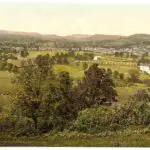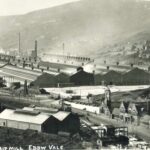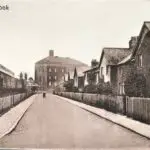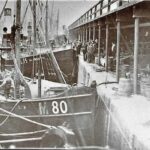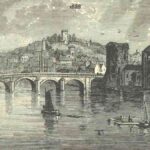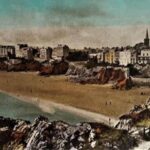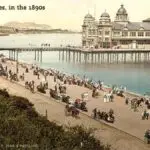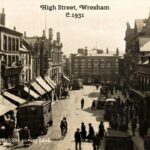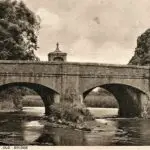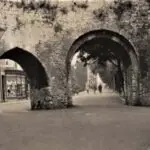The city and unitary authority area of Newport is found in the Southeastern corner of Wales. Once famous for its docks which transported huge quantities of coal throughout much of the industrial revolution, today the third largest city in Wales offers history enthusiasts a wide array of resources and attractions.
Newport History on Facebook
Facebook groups and pages are a great place to share memories, information and old photos. It can, however, be difficult to identify which Newport title relates to the city in Wales.
- Newport Local History Society
- Newport Museum and Art Gallery
- Old Newport
Local History Resources
There are a wide range of physical sources, societies and websites available, helping reveal aspects of local history in the area.
See: Old Photos & Films of Newport in Wales
Newport Central Library Digital Archive
Newport Reference Library maintains a local history collection of over 40,000 items, including books, Chartist manuscripts, and audio recordings.
You can access some of the material from the comfort of your own home, from the online Digital Archive.
Gwent Archives
A wide range of historic documents and records reside in the Gwent Archives, which serves the areas of Blaenau Gwent, Caerphilly, Monmouthshire, Newport and Torfaen.
Gwent Family History Society
The Gwent Family History Society has a Newport branch.
Gwent County History Association
The Gwent County History Association was established in 1998. Its objectives expanded in 2014, when it took over the activities of the Gwent Local History Council.
Newport Past .com
A nicely laid out website with a wide range of information about the city’s history, and lots of old pictures.
Industrial Gwent .co.uk
Dedicated to the industrial archaeology and history of Newport and Monmouth County, this website has a wide selection of photographs about each site of interest. The labelling is clear and packed with information.
Local Museums
The city and its immediate area offer an array of sites allowing visitors to glimpse many different points of local Welsh history.
The Roman Sites At Caerleon
The Romans established a fortress here in AD 75, four years before Mount Vesuvius erupted and buried the Italian cities of Herculaneum and Pompeii. At the western limit of the Roman empire, the fortress at Caerleon remained in operation for more than 200 years.
As a result, you can visit several different local sites dedicated to the Roman sites and artifacts discovered in the Newport area:
- The National Roman Legion Museum
- The Caerleon Roman Fortress and Baths museum
- Roman Barracks at Caerleon
- The Caerleon Ampitheatre
Newport Castle
Built in the 14th century, probably by Hugh de Audley, 1st Earl of Gloucester or his son-in-law, Ralph, Earl of Stafford, Newport Castle replaced a Norman motte somewhere nearby.
The castle was sacked by Owain Glyndŵr in 1402 and taken by Oliver Cromwell during the English Civil War in 1648.
Today, only the east side of the castle remains, and safety concerns led to the closure of public access.
Newport Museum and Art Gallery
On the same site as the City Library, the museum and art gallery are located on John Frost Square in Newport.
From the hunter-gatherers, to the Romans, Normans and Chartists, Newport’s history can be understood through the wide range of artefacts on display.
Tredegar House
On the edge of Newport you’ll find a country house built during the reign of Charles II. Now a Grade I listed building, the Restoration period house is now maintained by the National Trust.
In recent years the house has appeared on the Antiques Roadshow, Being Human, Da Vinci’s Demons and The Hairy Bikers.
Fourteen Locks
The industrial revolution increased the rate of goods and materials produced. The system demanded better transport systems to link centres of production with their national and international customers.
One part of the solution was the development of a canal network, which linked in to other transport networks.
Built in the 1790s, the Monmouthshire Canal connected Newport to Pontnewynydd in its main line, and Crindai (now Malpas) to Crumlin in a branch route.
In the Rogerstone area of Newport, you’ll find a part of the Crumlin branch route called the Cefn Flight. It holds fourteen locks, allowing the water to rise 160 feet (50 metres) in just 800 yards (740 metres).
Thanks to the tireless work of campaigners and volunteers since the 1960s, and financial help from organisations for major projects, this piece of industrial heritage has been rescued and restored for future generations.
More about Wales
- Old Images of Monmouth, Wales
- Old Images of Blaenau Gwent, Wales
- Old Images of Monmouthshire, Wales
- Old Images of Pembrokeshire, Wales
- Old Images of Llanybydder, Wales
- Old Images of Newport Castle, Wales
- Old Images of Tenby, Wales
- Old Images of Colwyn Bay, Wales
- Dr Thomas Macnamara, Minister of Labour
- The Myth Of The Llangernyw Yew, Conwy
- Wrexham, Wales: Old Photos & Films
- Barry, Wales: Old Photos & Films
- Cwmbran, Torfaen, Wales: Old Photos & Films
- Swansea, Wales: Old Photos & Films
- Pontypridd, Rhondda Cynon Taf: Old Photos & Film
- Newtown, Powys: Old Photos & Films
- Old Images of Haverfordwest, Pembrokeshire
- Local History Resources for Pembrokeshire, Wales
- Newport, Wales: Old Photos & Films
- Newport, Wales: Local History Resources
Back to Local History Videos home page


